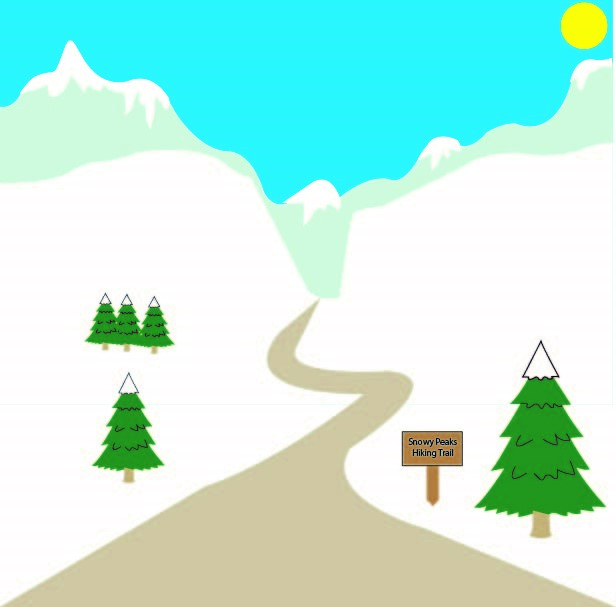Washington Winter Hikes
December 17, 2021
When venturing out on any of Washington’s hikes in the winter, it is important to be prepared as you may be traveling into avalanche and bear territory. To start with the ‘bear’ necessities, one article defines the 10 winter hiking essentials including warm, insulating layers, a map and compass, sun protection, warm clothing, a headlamp or flashlight, makeshift emergency shelters like a tarp or reflective blanket, a first aid kit, hydration supplies, fire starting supplies, repair tools, and nutrition. Sophomore Reidar Geraci disagrees, saying, “In the Winter it wouldn’t be that snowy around Issaquah. Normal shoes, warm clothes, extra jackets, and gloves would be my necessities.” While some of these supplies may seem like overkill, the wilderness can be unforgiving.
It is equally important to read trip reports and reviews before you go. Some of the most important steps you can take in preparation for your Washington winter hike is to read trip reports before you venture out. You can find these reports on AllTrails and the Washington Trail Association websites. If you are interested in the full extent of the Washington wilderness, senior Sharif Lacasse would aim to challenge himself, saying, “Backpacking is something difficult I would like to try.”
While venturing out on Washington winter hiking trails, it is important to pack the right gear for your trip. Snowshoes are for winter hikes in Washington with deep, powdery snow, and are an essential part of a fun hike experience. Junior Shanthi Hall agrees with this statement while listing her favorite winter activities: “Snowshoeing, sledding, and snowboarding.” Hiking poles are also a complementary addition to snowshoes to help you keep your balance on steeper terrain and uneven surfaces.
The best winter hiking boots for trails in Washington are those that have both insulation and are waterproof. Because you will get a heavy dose of both rain and snow in the Pacific Northwest, it is important to keep your feet warm and dry to spend the most time outside. Snow pants are necessary for Washington winter hikes like Hurricane Ridge, Artist Point, or Mt. Rainier. It is important to wear pants that are waterproof; this will keep you dry in sections of deep snow. Wearing a hat will help preserve your body heat when outside for long periods of time, so make sure you have one that covers your ears. Gloves are necessary when hiking in cold weather, but reserve mittens for times when you will be standing in one place taking pictures, resting, or having a quick snack.
Sunscreen may not seem essential, but the sun can reflect off the snow in the wintertime and burn your skin the same as the summer sun. Make sure you pack sunscreen for longer hikes on exposed ridges and places with few trees. If your heart is set on taking a Washington backcountry winter hiking adventure, it is recommended that you purchase an avalanche kit. An avalanche kit includes an avalanche beacon, avalanche probe, and a shovel at the least. These will increase your chances of survival in the case of an avalanche, and allow rescuers to find you or your party quickly. Freshman Sawyer Frye typically comes less prepared, saying, “On a Winter hike I would be sure to wear layers, a big coat, gloves, fuzzy socks, as well as carrying water and my phone.”
Moving on to destinations you will use the above tips for, here are six safe trails worthy of a winter adventure. Cedar and Pine Lake are located in the Bellingham Area for a 5.0 mile round trip and an elevation gain of 1400 feet. With two small lakes and many trail options that sport views to Mt. Baker and the Puget Sound, this moderate trail through the shady forest can be hiked or backpacked year round. If you decide to head up in the off season, you may be welcomed by an added layer of snow on the surrounding trees.
Heybrook Ridge is located in Stevens Pass for a 3.4 mile round trip and an elevation gain of 760 feet. The trailhead to Heybrook Ridge is at a low enough elevation that you may not be hiking through snow, but the mountain views at the top are better in the winter with a fresh blanket of powder. The hike is less than three and a half miles and gains less than 800 feet of elevation, making this a great choice for your whole family.
Green Mountain’s Gold Creek Trail is located on the Kitsap Peninsula for a 5.0 mile round trip and an elevation gain of 1000 feet. The trails around Green Mountain are close enough to the city for the perfect outdoor escape. If you have got time to do it in the daylight and there is a fresh blanket of snow, you will not want to miss this trail.
Fort Flagler State Park is located on the Hood Canal for a 5.0 mile round trip and an elevation gain of 150 feet. Fort Flagler State Park is one of five military installations that were established to protect Puget Sound from invaders during times of war. Although snow may be a rare sighting at Fort Flagler, this beach walk is still pretty satisfying in the winter.
Chelan Butte is located around Lake Chelan for a 7.46 mile round trip and an elevation gain of 2500 feet. These rolling hills just beyond Lake Chelan give a clear view of the mountains beyond. During the winter months, the area transforms as the landscape is even more dramatic when snow is falling all the way down to the lake.
Badger Mountain’s Canyon Trail is located in the Tri-Cities for a 3.25 mile round trip and an elevation gain of 1195 feet. This mountain just outside of Richland is a great place for locals and visitors to recreate. Views extend in every direction and include mountains, fields, and cityscapes. In the winter, the trails around Badger replicate that of a surreal tundra, but only 30 minutes from home.
Mount Spokane State Park’s Summit Route is located in the Spokane Area for a 4.0 mile round trip. Spokane State Park is popular all year long, but this exclusive winter route from Bald Knob campground welcomes a heaping of powder. Once at the summit, snowshoers are welcome to hike to the access point near the top of chair one in order to visit the 1934 Vista House. The ski area operates a weekend concession stand inside, so you could enjoy a cup of hot cocoa and relax by the fireplace before heading back or opting for more exploration on the extensive trail system.
Skiing seems like the biggest activity in winter, especially in Washington, where, Geraci states, “During winter it is not a long drive to skiing areas such as Snoqualmie and Crystal.” But, I urge you to venture out on one of our many trails and mountains on foot, or snowshoe. Washington is well known for many things, our coffee, apples, and the rainy season, but there are quite a few beaten paths to take when you know where to look. Frye sums it up perfectly when asked what Washington specializes in: “Hiking and our mountains go hand in hand to showcase our state’s specialities.”







